

 |
|
| Fish and Seaweed pattern is also known by the names: Fish Pond & Fish in Pond, and erroneously as Pseudopomona, Pseudo Pomona, Mid Western Pomona | |
 |
With the exception of the SUPER RARE unfrosted water bottle, all of my pieces have remnants of old paint on the frosted fish, gold, purple, black. The paint is very thin and not fired on. The seaweed is unpainted & unfrosted. |
| Confusion about the pattern has arisen because of the similarity of the texture on the surface of this pattern to Pomona glass which has caused some to call the pattern PSEUDOPOMONA in error. | |
| The background is frosted & there are little clear scallops around the necks similar to Pomona. In Old Pattern Glass According to Heacock, Heacock names the pattern Fish and Seaweed and shows a water pitcher. | 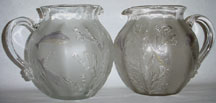 |
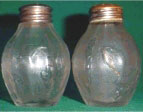 Salt & Pepper Shakers |
All pieces have internal vertical ribbing, are mould blown, have applied handles, finished lips and ground and polished pontils. The tumblers, toothpick holder, & water bottle have ground and polished rims. The "frosting" was either done by coarse grit sandblasting (as the surface is pitted but not uniformly) or by acid etching, like the technique used to produce Second Grind Pomona. |
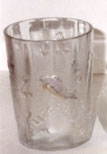 Water Tumbler |
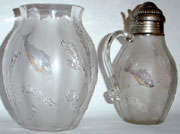 Celery Vase and Syrup Pitcher |
| I own: 3 water pitchers, 4 tumblers, 3 shakers, toothpick holder, syrup, 2 sugar bases-no lids, creamer, cruet with original stopper (outside vertical ribbing), celery vase, and 2 water bottles, 1 with the usual frosted background and 1 plain with no frosting. Heacock also lists a muffineer. | |
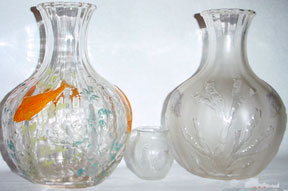 |
|
The unfrosted water bottle is 7 3/4" tall, 6" diameter & looks very different from the others. It is all clear & the fish have an ugly orange, original, paint on them. Plants, different from the seaweed, are painted over the seaweed and around in the background. The Bredehoft/Sanford Glass Toothpick Holders book says that the pattern was made by Model Flint Glass Co. of Albany, Indiana based on a 1904 catalogue drawing of a shaker but this has been proven to be incorrect. My "pet" theory is that the pattern was made by Harry Northwood when he was first employed by Hobbs, Brockunier, & Co. 1882-83!!!!! It is far-fetched but a slight possibility and gives rise to interesting conjecture about glass goings- on way back, long before any of us can now remember................. |